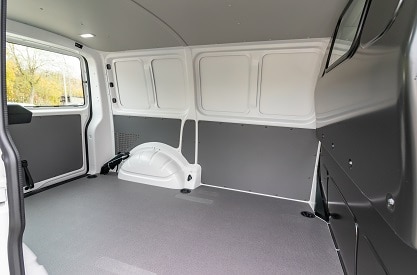Several different manufacturers make cargo vans, and each manufacturer makes several different types to their own specifications, so there is no one length for cargo vans.
When referring to the length of a cargo van, you probably need to know the length of the interior cargo section to determine what freight will fit inside.
Cargo vans have three different main size classes.,
The average dimensions (L x W x H) for the inside of cargo van by class:
Compact Cargo Van – 83” x 65” x 55”
Full Size Cargo Van – 126” x 56” x 55”
High Roof Cargo Van – 143” x 76” x 55”
There is one other class, and that is the Heavy Duty cargo van, its dimensions are similar to a full size cargo van, but it can carry a heavier payload.
When considering which cargo van to rent or buy though it is not just the length of the van which should be considered but also its overall capacity and its payload.
The capacity is the cubic space available to carry freight, and the payload is the total weight of that freight.
Capacity
As you would expect, the larger the dimensions of the cargo area, the more capacity it will have. This means if none of the items are particularly long and can be stacked on top of each other, a smaller cargo van may suit your purposes.
Payload
As well as ensuring your intended freight will fit in your cargo van, you must also ensure that the freight’s total weight is not too much for the van or its axles.
On average, the payloads for the three main types of cargo van are:
Compact Cargo Van – 1,480lbs
Full Size Cargo Van – 3,700lbs
High Roof Cargo Van – 3,700Lbs
What is perhaps worth noting here is that although a high roof cargo van may offer you more space for your freight, it may not necessarily allow it to have more weight.
Heavy Duty Cargo Vans
Some manufacturers make heavy-duty cargo vans that can perhaps carry a payload of as much as 4,080lbs. While these types of van are sturdier and perhaps more powerful, often they only offer the same freight capacity as other full size vans.
Those are the main four classes, but some manufacturers make cargo vans that have an extended length and can carry a heavier payload. These are often referred to as Heavy Duty XL Cargo Va
Some examples of these are:
- Ford Transit 350 Extended Cargo: Inside Dimensions (L x W x H) – 172” x 70.2” x 81.5”
- Dodge RAM ProMaster 350 High Extended: Inside Dimensions (L x W x H) – 160.2” x 75.6” x 76”
- Mercedes-Benz Sprinter Extended Cargo Van: Inside Dimensions (L x W x H) – 193.9” x 70.1” x 77.8”
As can be seen from their dimensions, these vans have a higher capacity meaning they can carry additional freight. Not only do these examples have more capacity some also afford a higher payload, as seen below:
Ford Transit 350 Extended Cargo:
- Capacity – 487.2 cu ft
- Payload – 3,500lbs
Dodge RAM ProMaster 350 High Extended:
- Capacity – 462.8 cu ft
- Payload – 4,340lbs
Mercedes-Benz Sprinter Extended Cargo Van:
- Capacity – 530.0 cu ft
- Payload – 4,934lbs
Cargo Van Length Prices
As with most other things the cost to rent or buy a cargo van will increase with its increased size.
Work out what space you need so you don’t waste money renting or buying a cargo van which is larger than your estimated requirements. Do not forget though that as well as size available in the cargo van you will also have to consider its maximum payload.
Compact Cargo Vans
As these are the smallest class of cargo vans they are easier to drive and park than the other classes but still provide a relatively large cargo space. These are perhaps becoming popular with small businesses that have multiple, light weight deliveries, such as caterers and florists.
Full Size Cargo Vans

These are perhaps the most common cargo vans, and while some rental agencies may offer an assortment of sizes some, like U-Haul will only offer the full-size cargo van for rental.
These full-size cargo vans are however, becoming increasing popular as they are often large enough to transport the furniture when moving apartments or even from a small house.
One of these vans, often referred to as a 9’ van, can hold a small couch, queen size bed, medium sized table or wardrobe, appliances or even a combination of several of these.
With the additional cargo capacity compared to a compact cargo van, they have become popular with small businesses such as plumbers, contractors, and other professionals.
High Roof Cargo Vans
While high roof cargo vans may not be able to offer a heavier payload, they do have the advantage of allowing most people to stand upright in them.
This is obviously beneficial if you are considering converting it to a camper. It is, however also beneficial to professionals who may need to work from different locations but also need to work from inside their van.
The ability to work standing up and yet still be protected from the weather is a plus for many small business owners. It also makes it easier for taller people to load and unload if they do not have to crouch down all the time.
Heavy Duty or Heavy Duty XL Cargo Vans
Several manufacturers make these, and while they may not be in as popular as the other cargo van classes, they do provide another alternative to the larger box vans.
Some small businesses need to move larger or heavier freight. Prior to the introduction of these heavy-duty XL cargo vans, they had no alternative than to use the larger, more cumbersome box trucks.
The box trucks do of course, serve their purpose but only allow access to the cargo section by a rear door. A cargo van that can meet some ones size and weight requirements plus afford access via a side door, rear door, and from the front can often be beneficial.
No Commercial Driver’s License
One of the reasons for the growing popularity of cargo vans is that in many States a commercial driver’s license (CDL) is not needed to drive a cargo van while one is required to drive most box vans.
Perhaps the reason for this is that the transport authorities acknowledge that more compact cargo vans are easier to drive than the longer, more powerful box vans.
Due to their shorter length and maneuverability, cargo vans are considered to handle more similarly to large SUVs rather than large trucks. This means that most drivers will have similar experiences when driving cargo vans, so a professional driver is not always required.
Van Length and Loading a Cargo Van
Regardless of the length of cargo van you choose, care still has to be taken in its loading. Just as with the larger box vans, the load must be evenly distributed to ensure no one axle weight is exceeded.
Conclusion
Many people today are renting or buying cargo vans, and if you are one of those people considering it you should ensure you get one which is the correct size for your personal needs.
This will mean that you will not just have to know how much space you will need in the van’s cargo section but also how much your freight will weigh.
Having decided on the size you need, you will then have to consider its GVWR to determine what type of license the driver will need and if it will be subject to commercial vehicle regulations.
When loading, always take safety precautions, such as securing loose items of freight. As a cargo van has no partition between the driver and the cargo section, it is also advisable to use a net which can protect the driver from loose freight whilst driving.
The use of a net or similar removable partition can help avoid accidents and can easily be removed once the van is parked.
Whilst cargo vans will never fully replace larger box vans, they are rapidly replacing them when it comes to transporting smaller, lighter loads. Since cargo vans were first introduced, there has been a gradual increase in their sizes and GVWR. If this trend continues, longer and heavier equipment may be able to be transported by cargo vans as they evolve.


